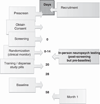Pilot study to show the feasibility of a multicenter trial of home-based assessment of people over 75 years old
- PMID: 20592583
- PMCID: PMC3526375
- DOI: 10.1097/WAD.0b013e3181d7109f
Pilot study to show the feasibility of a multicenter trial of home-based assessment of people over 75 years old
Abstract
This report describes a pilot study to evaluate feasibility of new home-based assessment technologies applicable to clinical trials for prevention of cognitive loss and Alzheimer disease.
Methods: Community-dwelling nondemented individuals >or=75 years old were recruited and randomized to 1 of 3 assessment methodologies: (1) mail-in questionnaire/ live telephone interviews (MIP); (2) automated telephone with interactive voice recognition (IVR); and (3) internet-based computer Kiosk (KIO). Brief versions of cognitive and noncognitive outcomes were adapted to the different methodologies and administered at baseline and 1-month. An Efficiency measure, consisting of direct staff-to-participant time required to complete assessments, was also compared across arms.
Results: Forty-eight out of 60 screened participants were randomized. The dropout rate across arms from randomization through 1-month was different: 33% for KIO, 25% for IVR, and 0% for MIP (Fisher Exact Test P=0.04). Nearly all participants who completed baseline also completed 1-month assessment (38 out of 39). The 1-way ANOVA across arms for total staff-to-participant direct contact time (ie, training, baseline, and 1-month) was significant: F (2,33)=4.588; P=0.017, with lowest overall direct time in minutes for IVR (Mn=44.4; SD=21.5), followed by MIP (Mn=74.9; SD=29.9), followed by KIO (Mn=129.4; SD=117.0).
Conclusions: In this sample of older individuals, a higher dropout rate occurred in those assigned to the high-technology assessment techniques; however, once participants had completed baseline in all 3 arms, they continued participation through 1 month. High-technology home-based assessment methods, which do not require live testers, began to emerge as more time-efficient over the brief time of this pilot, despite initial time-intensive participant training.
Figures
References
-
- Ferris SH, Aisen PS, Cummings J, et al. Alzheimer’s Disease Cooperative Study Group. ADCS Prevention Instrument Project: overview and initial results. Alzheimer Dis Assoc Disord. 2006;20(suppl 3,4):S109–S123. - PubMed
-
- Morris JC, Weintraub S, Chui HC, et al. The Uniform Data Set (UDS): clinical and cognitive variables and descriptive data from Alzheimer Disease Centers. Alzheimer Dis Assoc Disord. 2006;20:210–216. - PubMed
-
- Grundman M, Petersen RC, Ferris SH, et al. Alzheimer’s Disease Cooperative Study. Mild cognitive impairment can be distinguished from Alzheimer disease and normal aging for clinical trials. Arch Neurol. 2004;61:59–66. - PubMed
-
- Mundt JC, Kinoshita LM, Hsu S, et al. Telephonic remote evaluation of neuropsychological deficits (TREND): longitudinal monitoring of elderly community-dwelling volunteers using touch-tone telephones. Alzheimer Dis Assoc Disord. 2007;21:218–224. (2007) - PubMed
Publication types
MeSH terms
Grants and funding
LinkOut - more resources
Full Text Sources
Medical



